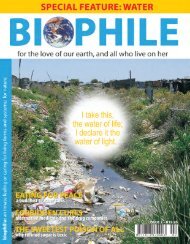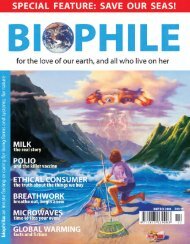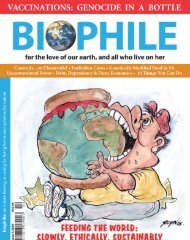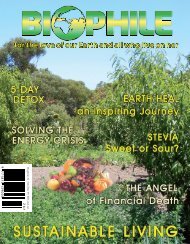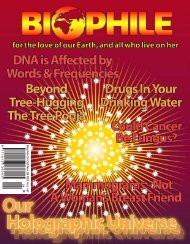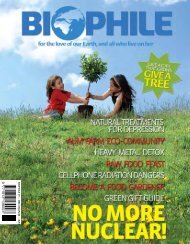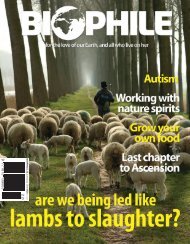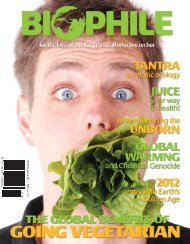BIOPHILE 16 â JUNE/JULY 2007 R25 - Biophile Magazine
BIOPHILE 16 â JUNE/JULY 2007 R25 - Biophile Magazine
BIOPHILE 16 â JUNE/JULY 2007 R25 - Biophile Magazine
- No tags were found...
Create successful ePaper yourself
Turn your PDF publications into a flip-book with our unique Google optimized e-Paper software.
How to be a GreenerCloth Nappy Userby Stacy FriedlanderThere has been a lot of talkabout cloth nappies latelyand I have heard many peoplerefer to some research done inthe UK by The EnvironmentalAgency¹ saying washing clothnappies has just as muchimpact on the environmentas disposables. This studyhas however been stronglycriticized by The Women’s EnvironmentalNetwork² (WEN)for statistical inaccuraciesdue to the small sample sizeof the cloth nappy users (117but further reduced to only 32users of terry squares for thereport) compared to disposablenappy users (2000).The biggest area of concernwhen reading The EnvironmentalAgency’s research isthe washing method that itstudied. Traditionally terrysquares were washed at veryhigh temperatures and soakedin chemical sanitizers. I stillget questions about whethernappies need to be boiled andsoaked in chemicals beforewashing. By basing the abovestudy on these washing methodsis not taking into accountthe more modern washingrecommendations by themanufactures of shaped clothnappy, which are fast becomingthe most popular form ofreusable nappies. No allowancewas also given for thedecrease in impact of secondhand nappies. My son (due tobe born next month) will bereusing all his sister’s nappies,and I hope that the secondhand market for cloth nappieswill grow in South Africa asit has in the UK and USA, notonly amongst siblings, butalso in nappies being resold.What we need to takefrom this report is that notall washing methods can beconsidered equal in their environmentalfootprint. Thereis a lot that cloth nappy userscan do to make a noticeablereduction in the environmentalimpact. WEN concludedthat significant energy savingscan be made when using 24nappies, washing at no morethan 60°C in an A-rated washingmachine thus cutting thecontribution to global warmingby 17% compared to the 47nappies and washing methodssuggested by The EnvironmentalAgency’s research.Greener ways to reduce theenvironmental impact of usingcloth nappies:• If financially possible,choose nappies made fromorganic cotton, hemp or bamboowhich are grown with lessimpact on the environment.• Buy nappies from a localsupplier - most importednappies are flown into thecountry causing huge carbonemissions.• Buy second hand nappiesor reuse nappies with subsequentbabies.• Avoid soaking. Dry storenappies in a bucket with aclose fitted lid. If you do soakavoid using sanitizers. Ratheruse a natural agent like lavenderoil or an organic nappysoak like that available fromEnchantrix.• Nappies that are wet onlycan be washed at 40°C andsoiled nappies at a maximumof 60°C• Use a washable nappy liner• Avoid PVC waterproof covers• Make sure your washingmachine has an A rating forenergy efficiency and if yourmachine does not adjust thewater volume to the weight ofthe load automatically then alwayswash a full load. Towelsand other items of clothes canbe added to make a full load.• Use an environmentallyfriendly washing detergent.Organic laundry liquid isavailable from Enchantrix• Do not use a fabric softener,it reduces the absorbency ofthe nappies and is an unnecessarychemical pollutant.White Spirit Vinegar can beadded to the final rise water ifyou feel softening is required.• Line or air dry where everpossible and avoid using thetumble dryer.• Nappies never need to beironed• Sell or pass on your nappieswhen you are finished withthem.Using the above methodswill certainly make usingcloth nappies much moreenvironmentally friendly thandisposables. As parents we do,after all, have a responsibilityto the children we are raisingto limit the damage we do tothis planet, and try to repairsome of the damage we havealready done.1) The Environmental Agency Report:http://www.environment-agency.gov.uk/commondata/acrobat/nappies_1072099.pdf2) The Women’s Environmental Networkcomments: http://www.wen.org.uk/general_pages/Newsitems/ms_LCA19.5.05.htmOther source of information Twinkle-Twinkle www.twinkleontheweb.co.uk30 <strong>Biophile</strong> Issue <strong>16</strong>



